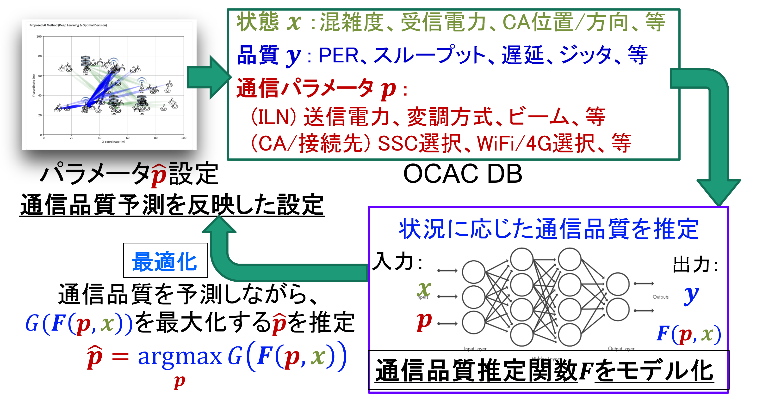Progress Report
Reliability-ensuring Cybernetic Avatar Infrastructure Allowing Interactive Teleoperation[5] Development of Reliability-ensuring Platform with Jitter Reduction and Low Latency
Progress until FY2024
1. Outline of the project
Based on the architecture designed to ensure end-to-end (E2E) communication reliability, we have proceeded with a demonstration using the prototype “Support Node.” Additionally, we introduced a dual-arm robot to simulate a cybernetic avatar (CA) and visualize the impact of communication degradation on teleoperation. Even under identical communication conditions, we demonstrated that routing through the Support Node helps avoid error-prone paths and reduces jitter in control signal arrival times, thereby stabilizing teleoperation.
Furthermore, we advanced the development of extended information-centric networking (ICNx) technology, essential for enabling M×N communication. in addition to ICN’s original ability to distribute data simultaneously to multiple endpoints, we incorporated in-network recovery functions to achieve more stable and higher-capacity communication for CA.
2. Outcome so far
To achieve stable remote operation, we developed a prototype of reliability-ensuring platform called the Support Node, equipped with functions for monitoring and visualizing communication quality, dynamic path control, and a jitter buffering. We conducted multiple demonstration experiments using a dual-arm robot at various domestic and international sites and received high acclaim, including a Best Paper Award at an international conference [1]. Furthermore, we measured communication characteristics at 12 locations in Japan and abroad, successfully collecting distinctive communication quality data. Using this data, we successfully recreated similar communication environments with a network emulator, establishing an evaluation method capable of simulating real-world conditions without the need for on-site testing. This achievement contributes foundational data for optimizing network control.
To enable integration between the CA platform and the reliability-ensuring platform, we are organizing the required interfaces, types of information to be exchanged, and related challenges. In parallel, we have investigated international trends in communication standardization related to this project, and compiled a standardization roadmap for the reliability-ensuring platform. Based on this roadmap, we are preparing a contribution to ITU-T focused on CA teleoperation use cases.

We have also advanced the development of ICNx using the open-source framework Cefore [2], to enable high-bandwidth, low-latency communication between CAs and teleoperators. In FY2024, we developed an in-network recovery function that detects missing packets in the network and promptly requests retransmission and forwarding. With this function, we confirmed that 99% of transmissions complete within 100 ms in stable networks, and over 90% even in unstable environments as shown in Figure 2. This result will be presented at a prominent international conference [3].
- [1] SmartCom 2024(http://ieice-smartcom.info/2024/)
- [2] Cefore(https://github.com/cefore/)
- [3] IFIP Networking 2025 (https://networking.ifip.org/2025/)

3. Future plans
We will integrate control logic and hardware control components developed in other related projects into the Support Node, and proceed with verifying optimization methods for M×N control across the entire network.
In our research on the E2E communication protocol ICNx, we aim to extend the current in-network recovery functionality to realize a protocol that can simultaneously reduce communication delay between multiple CAs and teleoperators.
These outcomes will be validated through joint demonstration experiments with other Socio-CA projects, and we will also advance proposal activities to relevant international standardization bodies.